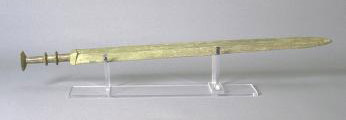Ch’in
(221 – 206 BC)
By 230 BC the other Warring States had worn themselves down to a remaining six. Then the Ch’in armies moved eastward. Within the decade each of the six was conquered, and China was unified under Ch’in’s king. As his first act, he bestowed upon himself the title Shihuangdi, or the “First August Emperor.” In this pivotal year of 221 BC, the land took its name from this dynasty, thus the Middle Kingdom became known as China.
Long Sword
c. 221- c. 1st century
Ch'in - Han Period
bronze
24 inches

Courtesy The University of Michgan Art Museum
The First
Emperor’s reign was brief but busy. In twelve years he accomplished
much, standardizing the Chinese script, width of roads, weights and measures,
and metal currency. He undertook monumental building projects including
constructing over 4,000 miles of tree-lined imperial highways and over
2,000 miles of the Great Wall. Untold numbers of new palaces were built,
including an immense edifice for his primary residence called the Nearby
Palace. In the midst of all this, the First Emperor increased the size
of his army with which he defended his borders and conquered new lands.